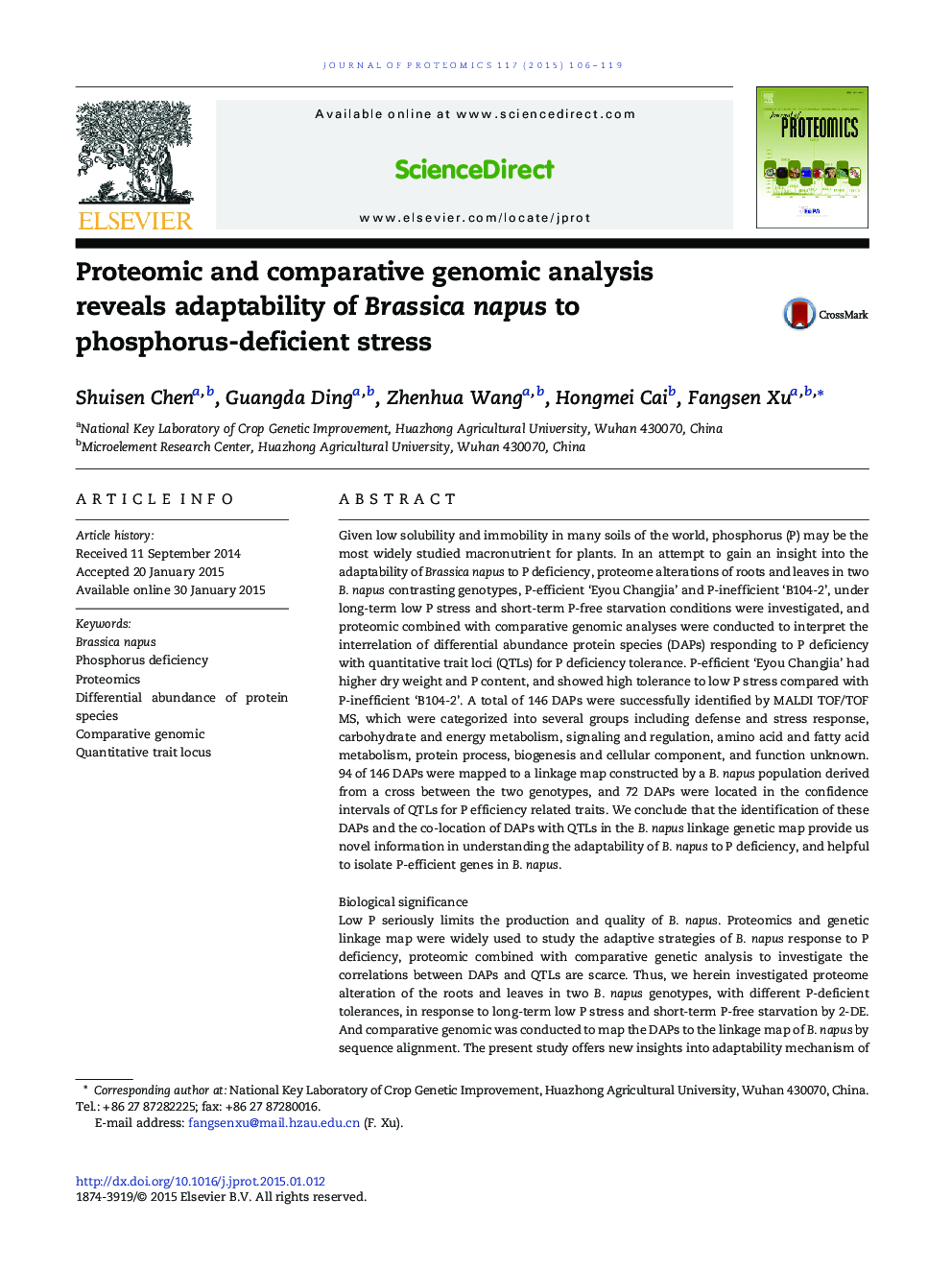| کد مقاله | کد نشریه | سال انتشار | مقاله انگلیسی | نسخه تمام متن |
|---|---|---|---|---|
| 1225707 | 1494763 | 2015 | 14 صفحه PDF | دانلود رایگان |

• Long-term low P stress and short-term P-free starvation were conducted.
• Root and leaf proteomes from two different P tolerance B. napus genotypes were compared by 2-DE.
• Comparative genomic was conducted to investigate the correlation between DAPs and QTLs.
• Of 146 DAPs, 94 were mapped to a linkage map and 72 were located in the confidence intervals of QTLs.
• 8 protein species were validated in RNA level by real-time qPCR.
Given low solubility and immobility in many soils of the world, phosphorus (P) may be the most widely studied macronutrient for plants. In an attempt to gain an insight into the adaptability of Brassica napus to P deficiency, proteome alterations of roots and leaves in two B. napus contrasting genotypes, P-efficient ‘Eyou Changjia’ and P-inefficient ‘B104-2’, under long-term low P stress and short-term P-free starvation conditions were investigated, and proteomic combined with comparative genomic analyses were conducted to interpret the interrelation of differential abundance protein species (DAPs) responding to P deficiency with quantitative trait loci (QTLs) for P deficiency tolerance. P-efficient ‘Eyou Changjia’ had higher dry weight and P content, and showed high tolerance to low P stress compared with P-inefficient ‘B104-2’. A total of 146 DAPs were successfully identified by MALDI TOF/TOF MS, which were categorized into several groups including defense and stress response, carbohydrate and energy metabolism, signaling and regulation, amino acid and fatty acid metabolism, protein process, biogenesis and cellular component, and function unknown. 94 of 146 DAPs were mapped to a linkage map constructed by a B. napus population derived from a cross between the two genotypes, and 72 DAPs were located in the confidence intervals of QTLs for P efficiency related traits. We conclude that the identification of these DAPs and the co-location of DAPs with QTLs in the B. napus linkage genetic map provide us novel information in understanding the adaptability of B. napus to P deficiency, and helpful to isolate P-efficient genes in B. napus.Biological significanceLow P seriously limits the production and quality of B. napus. Proteomics and genetic linkage map were widely used to study the adaptive strategies of B. napus response to P deficiency, proteomic combined with comparative genetic analysis to investigate the correlations between DAPs and QTLs are scarce. Thus, we herein investigated proteome alteration of the roots and leaves in two B. napus genotypes, with different P-deficient tolerances, in response to long-term low P stress and short-term P-free starvation by 2-DE. And comparative genomic was conducted to map the DAPs to the linkage map of B. napus by sequence alignment. The present study offers new insights into adaptability mechanism of B. napus to P deficiency and provides novel information in map-based cloning to isolate the genes in B. napus and scientific improvement of P-efficient in practice.
Figure optionsDownload high-quality image (119 K)Download as PowerPoint slide
Journal: Journal of Proteomics - Volume 117, 18 March 2015, Pages 106–119